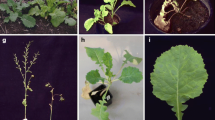Abstract
Big-vein disease (BV) of lettuce has been attributed to infection by Lettuce big-vein virus (LBVV), vectored by the soil fungus Olpidium brassicae. The finding of a second soil-borne virus in lettuce, Mirafiori lettuce virus (MiLV), led to a re-investigation of the role of LBVV in big-vein disease, with evidence emerging that both MiLV and LBVV are vectored by O. brassicae, and that MiLV, not LBVV, is the cause of BV (Lot et al. (2002), Phytopathology 92: 288–293). The two viruses have coat proteins of similar size but have different morphologies and are serologically unrelated. We tested individual lettuce plants in BV-prone fields and protected crops in France and Italy for the presence of the two viruses, using DAS-ELISA and antisera specific for each virus. Both MiLV and LBVV were found at high incidence, often together but sometimes separately. Symptoms were frequently found to be associated with MiLV alone or both viruses, but rarely LBVV alone. However, no absolute correlation emerged, because sometimes MiLV was present in the absence of symptoms, and vice versa. To clarify the situation, individual lettuce plants were examined over a period of time in two further surveys. In surveys of protected crops in France, plants with big-vein were always ELISA-positive for MiLV, or else symptomless plants positive for MiLV were later seen to develop big-vein symptoms. Presence or absence of LBVV appeared to have no effect on symptom development. In surveys of open fields in Italy, all combinations were found: presence of both viruses, apparent absence of both viruses, or presence of each one alone, in plants that developed BV. At the end of the observation period, nearly all plants had BV and contained both viruses.
Similar content being viewed by others
References
Bos L and Huijberts N (1990) Screening for resistance to big-vein disease of lettuce (Lactuca sativa). Crop Protection 9: 446-452
Campbell RN and Grogan RG (1964) Acquisition and transmission of lettuce big-vein virus by Olpidium brassicae. Phytopathology 54: 681-690
Falk BW (1997) Lettuce big-vein. In: Davis RM, Subbarao KV, Raid RN and Kurtz EA (eds) Compendium of Lettuce Diseases. American Phytopathological Society, St. Paul, MN, USA
Huijberts N, Blystad DR and Bos L (1990) Lettuce big-vein virus: Mechanical transmission and relationships to tobacco stunt virus. Annals of Applied Biology 116: 463-475
Jagger IC and Chandler N (1934) Big vein, a disease of lettuce. Phytopathology 24: 1253-1256
Kuwata S and Kubo S (1984) Properties of two Olpidium transmitted viruses: Tobacco stunt and lettuce big-vein. Abstracts, Sixth International Congress of Virology (p 331) Sendai, Japan, P45-2
Kuwata S, Kubo S, Yamashita S and Doi Y (1983) Rod-shaped particles, a probable entity of lettuce big-vein virus. Annals of the Phytopathological Society of Japan 49: 246-251
Lot H, Campbell RN, Souche S, Milne RG and Roggero P (2002) Transmission by Olpidium brassicae of Mirafiori lettuce virus and Lettuce big-vein virus, and their roles in lettuce big-vein etiology. Phytopathology 92: 288-293
Mayo MA (2000) Genus Varicosavirus. In: van Regenmortel MHV, Fauquet CM, Bishop DHL, Carstens EB, Estes MK, Lemon SM, Maniloff J, Mayo MA, McGeogh DJ, Pringle CR and Wickner RB (eds) Virus Taxonomy. Seventh Report of the International Committee on Taxonomy of Viruses, Academic Press, San Diego, USA
Revers F, Lot H, Souche, S, Le Gall O, Candresse T and Dunez J (1997) Biological and molecular variability of lettuce mosaic virus isolates. Phytopathology 87: 397-403
Roggero P, Ciuffo M, Vaira AM, Accotto Gp, Masenga V and Milne RG (2000) An Ophiovirus isolated from lettuce with big-vein symptoms. Archives of Virology 145: 2629-2642
Tomlinson JA and Garrett RG (1964) Studies on lettuce big-vein and its vector Olpidium brassicae (Wor.) Dang. Annals of Applied Biology 54: 45-61
Verbeek M, Van DerWilk F, Vetten HJ and Van Der Heuvel JFJM (2001) Viruses associated with the lettuce big-vein syndrome. Abstract Arbeitskreis Viruskrankheiten der Pflanzen Tagung 2001, Köln, 29-30 March 2001
Vetten HJ, Lesemann D-E and Dalchow J (1987) Electron microscopical and serological detection of virus-like particles associated with lettuce big-vein disease. Journal of Phytopathology 120: 53-59
Walsh JA (1994) Effects of some biotic and abiotic factors on symptom expression of lettuce big-vein virus in lettuce (Lactuca sativa). Journal of Horticultural Science 69: 21-28
Westerlund FV, Campbell RN and Grogan RG (1978) Effect of temperature on transmission, translocation, and persistence of the lettuce big-vein agent and big-vein symptom expression. Phytopathology 68: 921-926
Author information
Authors and Affiliations
Rights and permissions
About this article
Cite this article
Roggero, P., Lot, H., Souche, S. et al. Occurrence of Mirafiori Lettuce Virus and Lettuce Big-vein Virus in Relation to Development of Big-vein Symptoms in Lettuce Crops. European Journal of Plant Pathology 109, 261–267 (2003). https://doi.org/10.1023/A:1023060830841
Issue Date:
DOI: https://doi.org/10.1023/A:1023060830841




